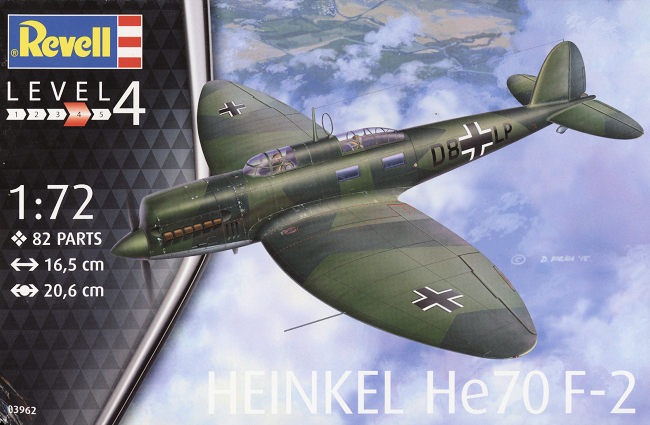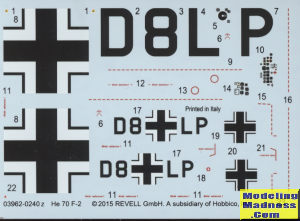
Revell 1/72 He-70F-2
| #: | 03962 |
| PRICE: | $11.98 |
| DECALS: | One option |
| REVIEWER: | Scott Van Aken |
| NOTES: | Reboxed ICM kit |

| HISTORY |
The Heinkel He 70 Blitz was designed in the early 1930s to serve as a fast mailplane for Deutsche Lufthansa. The He 70 was developed in response to Lufthansa request for a faster aircraft than the Lockheed Vega and Orion (as used by Swissair) for employment on short routes. It was a low-wing monoplane, with the main characteristics of its revolutionary design its elliptical wing, which the Günther brothers had already used in the Bäumer Sausewind sports plane before they joined Heinkel, and its small, rounded control surfaces. In order to meet the demanding speed requirements, the design minimised drag, with countersunk rivets giving a smooth surface finish and a retractable undercarriage, a novel feature for a German aircraft. It was powered by a BMW VI V-12 engine, cooled by ethylene glycol rather than water, allowing a smaller radiator and therefore reducing drag. The pilot and radio operator were seated in tandem, with a cabin housing four passengers on two double seats facing each other.
The first prototype flew on 1 December 1932, and proved to have excellent performance, setting eight world records for speed over distance, and reaching a maximum speed of 377 km/h (222 mph).
Lufthansa operated He 70s between 1934 and 1937 for fast flight service which connected Berlin with Frankfurt, Hamburg and Cologne, as well as the Cologne/Hamburg route. Lufthansa He 70s were flown abroad from Stuttgart to Sevilla between 1934 and 1936. Remaining aircraft were transferred to the Luftwaffe in 1937.
Twenty-eight aircraft were sent with the Legion Kondor, where they were used during the Spanish Civil War as fast reconnaissance aircraft. Their high speed gave them the nickname Rayo (lightning).
The He 70K (later He 170), a fast reconnaissance airplane variant was used by the Royal Hungarian Air Force in early World War II during 1941-42. The Luftwaffe operated He 70s from 1935, initially as a light bomber and reconnaissance aircraft, later as a liaison and courier aircraft.
The main weakness of the He 70 design soon became obvious. The He 70 airframe was made out of so-called "electron metal", a very light, yet strong alloy of magnesium, which burns spontaneously in air when heated, and is only exhausted when covered in sand. A single hit from a light machine gun usually set the entire plane ablaze, killing the crew. The Hungarian He 70K fleet was promptly retired and replaced with vintage, high-wing He 46 monoplanes until modern Bf 109 fighter-recce and specialized Fw 189 "Uhu" medium altitude observation aircraft could be introduced.
| THE KIT |
 Prior
to the release of this kit, the He-70 was only available as a standard plastic
kit by Matchbox. While a pretty nice kit as things go, it was designed more for
ease of construction than anything else. Though it is reasonably accurate in
shape, its detailing is not what one would call fine. This kit as with other
Matchbox kits, has been reissued by Revell, who purchased the company several
years back. In fact, I thought that this was the Matchbox kit when I bought it,
but was pleasantly surprised to find it was the ICM tooling.
Prior
to the release of this kit, the He-70 was only available as a standard plastic
kit by Matchbox. While a pretty nice kit as things go, it was designed more for
ease of construction than anything else. Though it is reasonably accurate in
shape, its detailing is not what one would call fine. This kit as with other
Matchbox kits, has been reissued by Revell, who purchased the company several
years back. In fact, I thought that this was the Matchbox kit when I bought it,
but was pleasantly surprised to find it was the ICM tooling.
ICM's kit is nicely molded in a standard grey plastic. There is a bit of flash on a few parts, though I did not see any of the molding glitches I found on an ICM boxing I have of the G. The fabric representation is quite subdued, something that most will appreciate. Separate ailerons, flaps, and rudder are provided. There are also wing spars to help with wing alignment, something I know I like.
Both the cockpit and cabin area are well appointed for the scale. The
design of the kit is in keeping with doing different variants as the next will
be a G model. I should mention that the inner wheel well walls are a separate
piece. The landing gear are also w ell
done and somewhat complex. This version used a tail skid so you can take the
wheel and resign it to the spares box along with a few other pieces.
ell
done and somewhat complex. This version used a tail skid so you can take the
wheel and resign it to the spares box along with a few other pieces.
Instructions are quite well done with half the pages being warnings in multiple languages and a color chart that features Revell paints. Thankfully, no mixing is required. The decal sheet is a Revell one so none of the issues one frequently has with ICM decals. The markings are for an RLM 70/71/65 plane based in Germany during 1943. No swastika is supplied.
| CONCLUSIONS |
The He-70 is not a type that stirs the interest of most model companies. However, it is a very nice looking aircraft, even in war paint and having it available at less than half the ICM price is a nice bonus.
March 2018
Copyright ModelingMadness.com. All rights reserved.
Thanks to
for the preview kit. You can find this kit at your favorite hobby shop
or on-line retailer. If you would like your product reviewed fairly and
fairly quickly, please
contact
the editor
or see other details in the
Note to
Contributors.
Back to the Main Page
Back to the Review
Index Page
Back to the Previews Index Page